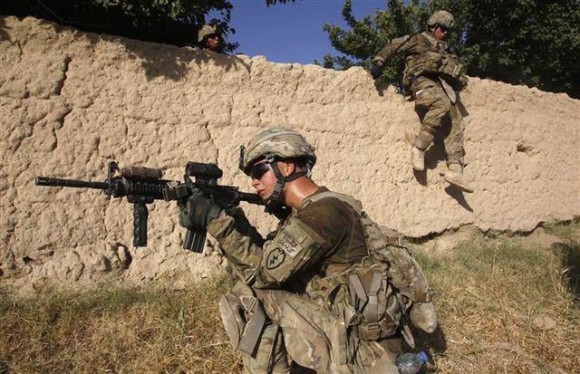
A recently commissioned Pentagon review corresponds with earlier intelligence assessments in predicting that once the U.S. draws down in Afghanistan, the Taliban will surge.
Afghanistan will require tens of thousands more troops costing billions more dollars than Nato envisioned at a fateful 2012 summit, according to a new Pentagon-sponsored review.
The review, released Thursday and conducted by the nonpartisan think tank CNA at the behest of the Pentagon’s policy directorate, found that the Taliban insurgency is likely to swell in the years following the upcoming US and Nato military withdrawal, sharply challenging expectations set at Nato’s May 2012 summit in Chicago. The review also saw widespread deficiencies in Nato’s planning for Afghanistan manpower, logistics, air support and ministerial strength.
The review comes as the US has all but given up on President Hamid Karzai assenting to a residual US military force, complete with basing rights, and passing off agreement on a post-2014 foreign presence to the winner of Afghanistan’s imminent elections.
The CNA review panel, which included a former Marine Corps commandant and US Army chief of staff, found that the persistent Taliban insurgency will mount an increased threat to the Afghan government for years after the envisaged Nato withdrawal, and require a force substantially larger and more expensive than Nato has planned.
It simply cannot be any clearer that tens of thousands of U.S. troops were sent to fight and die for a war that, by every observable metric, has been lost. The client state Washington tried to establish is barely even a state, lacking control of most of the country and unable to maintain even the merest security forces on its own. What is there is based on corruption and backwardness. Washington has been happy enough to support weak and corrupt regimes in the past, but there is deep distrust and even outright animosity between the U.S. and the Kabul government, making any effective working relationship beyond 2014 a joke.
As this study shows, the one objective that was perhaps the most obvious in Afghanistan from the beginning – to oust the Taliban and eliminate their presence in the country – is also a complete failure. The insurgency is alive and well and may even get stronger as the U.S. draws down. The U.S. was not able to defeat the Taliban.
The only thing worse than failing miserably on every count is the fact that all of this was predictable. A little history lesson about Afghanistan’s past as a place where foreign occupying powers are bled dry – along with some modesty in terms of our ability to reshape societies through our violent foreign policy – would have led reasonable people to conclude that a long-term occupation and nation building project in Afghanistan was not going to produce results acceptable to Washington. The decision could have been made early on to not waste trillions of dollars and countless lives and limbs on a war destined to fail even by the crude standards of policymakers.
It’s hard to look at Afghanistan and not conclude that the U.S. troops sent to fight and die there did so in vain. Neither they nor the untold Afghans who have suffered under a decade of foreign occupation endured this hell for any greater ends or larger purpose. It was all just the short-sightedness of politicians and the deluded military officials who proved all too willing to dive head first into this lost cause.
Last month, former U.S. Marine Jim Gourley put it succinctly enough, arguing that U.S. troops absolutely “died in vain.”
It’s the disgrace of a country that abandoned its civic duty to execute due diligence in weighing the decisions of whether and how to go to war, and then later to hold accountable those that spent precious blood and vast treasure for meager gains. All the while, we convinced ourselves that we were supporting our fighting forces simply by saying that we were. We even made bumper stickers to prove it, never considering what it said about us to wear our hearts next to our exhaust pipes.
Read the rest of it here.


